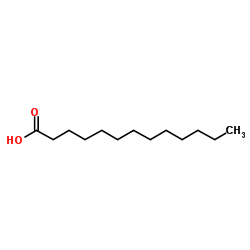Tridecylic acid

Tridecylic acid structure
|
Common Name | Tridecylic acid | ||
|---|---|---|---|---|
| CAS Number | 638-53-9 | Molecular Weight | 214.344 | |
| Density | 0.9±0.1 g/cm3 | Boiling Point | 308.2±5.0 °C at 760 mmHg | |
| Molecular Formula | C13H26O2 | Melting Point | 41-42 °C(lit.) | |
| MSDS | Chinese USA | Flash Point | 139.6±12.5 °C | |
| Symbol |

GHS07 |
Signal Word | Warning | |
|
Direct quantification of fatty acids in wet microalgal and yeast biomass via a rapid in situ fatty acid methyl ester derivatization approach.
Appl. Microbiol. Biotechnol. 99 , 10237-47, (2015) Accurate determination of fatty acid contents is routinely required in microalgal and yeast biofuel studies. A method of rapid in situ fatty acid methyl ester (FAME) derivatization directly from wet fresh microalgal and yeast biomass was developed in this stu... |
|
|
Use of multivariate statistical techniques to optimize the separation of 17 capsinoids by ultra performance liquid chromatography using different columns.
Talanta 134 , 256-63, (2015) In this work a multivariate statistical tool (Derringer and Suich optimization) was proposed for the separation of seventeen capsinoids (natural and synthetic) using the UHPLC-DAD chromatography. Capsinoids were analyzed at 280 nm. The variables optimized wer... |
|
|
Direct Derivatization vs Aqueous Extraction Methods of Fecal Free Fatty Acids for GC-MS Analysis.
Lipids 50 , 681-9, (2015) A comprehensive and accurate determination of free fatty acids (FFA) is required for fecal metabolomic investigations. The present study compares three aqueous extraction methods (1) ULTRA-TURRAX(®), (2) whirl mixing and (3) basic ULTRA-TURRAX extraction of f... |
|
|
An efficient and economical MTT assay for determining the antioxidant activity of plant natural product extracts and pure compounds.
J. Nat. Prod. 73 , 1193-5, (2010) Antioxidants scavenge free radicals, singlet oxygen, and electrons in cellular redox reactions. The yellow MTT [3-(4,5-dimethylthiazole-2-yl)-2,5-diphenyltetrazolium bromide] is reduced to a purple formazan by mitochondrial enzymes. NADPH is the basis of esta... |
|
|
Untargeted metabolomic analysis for the clinical screening of inborn errors of metabolism.
J. Inherit. Metab. Dis. 38 , 1029-39, (2015) Global metabolic profiling currently achievable by untargeted mass spectrometry-based metabolomic platforms has great potential to advance our understanding of human disease states, including potential utility in the detection of novel and known inborn errors... |
|
|
The effect of aliphatic carboxylic acids on olfaction-based host-seeking of the malaria mosquito Anopheles gambiae sensu stricto.
J. Chem. Ecol. 35(8) , 933-43, (2009) The role of aliphatic carboxylic acids in host-seeking response of the malaria mosquito Anopheles gambiae sensu stricto was examined both in a dual-choice olfactometer and with indoor traps. A basic attractive blend of ammonia + lactic acid served as internal... |
|
|
Conjugated fatty acids and methane production by rumen microbes when incubated with linseed oil alone or mixed with fish oil and/or malate.
Anim. Sci. J. 86 , 755-64, (2015) We hypothesized that manipulating metabolism with fish oil and malate as a hydrogen acceptor would affect the biohydrogenation process of α-linolenic acid by rumen microbes. This study was to examine the effect of fish oil and/or malate on the production of c... |
|
|
Exploratory Metabolomic Analyses Reveal Compounds Correlated with Lutein Concentration in Frontal Cortex, Hippocampus, and Occipital Cortex of Human Infant Brain.
PLoS ONE 10 , e0136904, (2015) Lutein is a dietary carotenoid well known for its role as an antioxidant in the macula, and recent reports implicate a role for lutein in cognitive function. Lutein is the dominant carotenoid in both pediatric and geriatric brain tissue. In addition, cognitiv... |
|
|
The association between linoleic acid levels in colostrum and child cognition at 2 and 3 y in the EDEN cohort.
Pediatr. Res. 77 , 829-35, (2015) Breastfeeding has been associated with improved cognitive development. This may be explained by polyunsaturated fatty acid (PUFA) content of breast milk, especially long-chain (LC) PUFA that are needed for postnatal brain growth.Using data from the French EDE... |
|
|
Milk fatty acids as possible biomarkers to diagnose hyperketonemia in early lactation.
J. Dairy Sci. 98 , 5211-21, (2015) The aim of this study was to assess the potential of milk fatty acids as diagnostic tool for hyperketonemia of 93 dairy cows in a 3×2 factorial arrangement. Cows were fed a glucogenic or lipogenic diet and originally were intended to be subjected to a 0-, 30-... |